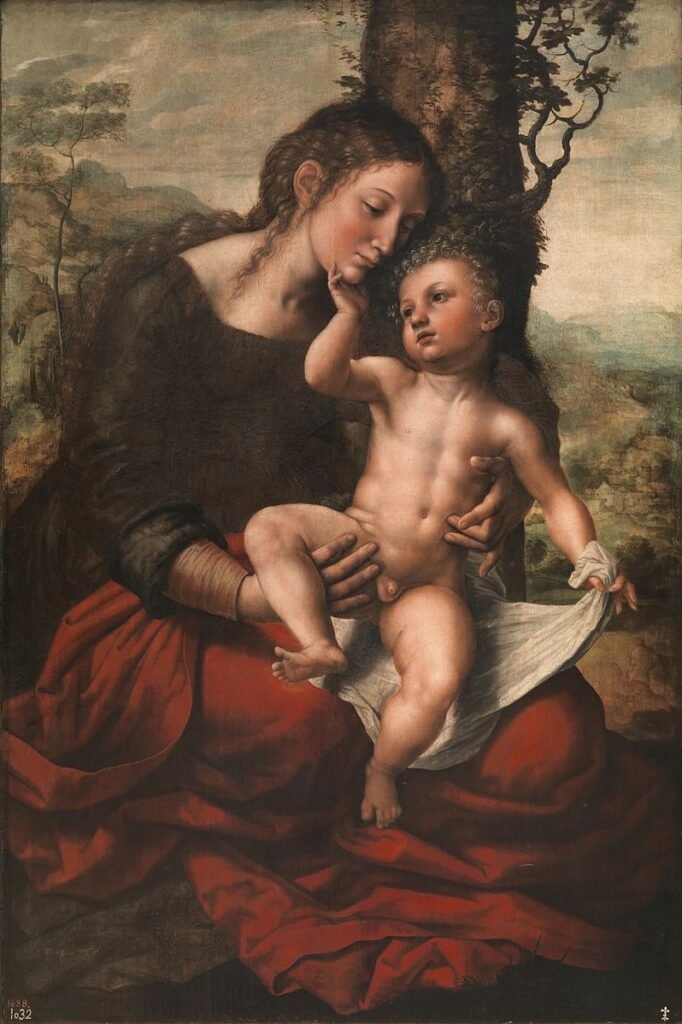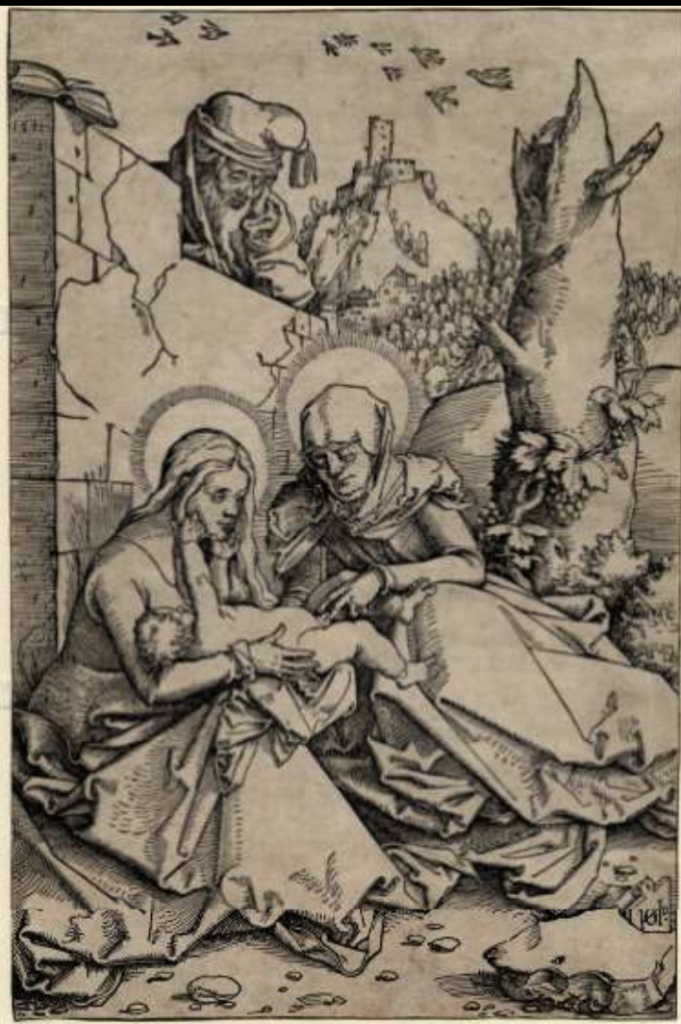We are a symbol-minded species. We create symbols and live by them. They pervade our assumptions and suggest to us ways to express and apply them. In religion—as in mathematics—symbols enable us to consider and reflect. In that sense, the Nativity crèche both charms and instructs. It is a conventional way to symbolize the Incarnation.
Every year while my children were young, the traditional tableau spread out under the Christmas tree. Mary and Joseph waited for midnight when the infant would be placed in a manger filled with real straw. A chipped donkey looked on. A single camel, carved in soapstone, accompanied the plaster Magi. One shepherd stood with a lamb draped around his neck. Another held a staff while his eye was on the sheep. Two kneeling angels kept guard from the corners of a wooden stable.

While we laid the tiny infant in his crib, we sang a song taught to me in first grade. It had been written by the parish priest who offered a Sunday children’s Mass in the school auditorium:
Happy Birthday, Jesus
You’re our God we know.
See the gifts we bring you:
Our hearts as white as snow.
After Christmas Day, the figurines were played with. Three kings took turns giving the baby camel rides. Shepherds wandered off to scout the terrain. Mary and Joseph, still on their knees, sought fresh air outside the brown plastic fence around the sacred compound. The donkey roamed with the sheep. Only the angels stayed put.

That ensemble had been with me for as many Christmases as I can remember. I took it along when I left home at twenty-one. It was one of scant belongings packed into a tired, secondhand Hillman with a manual clutch that just made it from the Bronx to a rented room at 10 Kelly Road, Cambridge. A light-weight 11-inch TV, a portable Smith-Corona typewriter, a tea kettle, and some mismatched dishware were basics for a down-market hope chest. One aluminum pot, a cast-iron fry pan, a few books, and fewer clothes made up the rest.
These were stuffs for an untried future. But the crèche, with its five-and-dime store troupe of players, betokened my history. Leaving a life behind, I took the emblem of it with me.
Perhaps because the Nativity set was a relic of childhood—mine and my children’s—I associate it with the nursery. It is an uncomplicated sign system graspable by the very young. It belongs to them.
• • • • •
A practical-minded son wanted to know: “If the Wise Men brought gold, frankincense, and myrrh, what did Mary and Joseph do with the gold?” I had no answer.
• • • • •
“I heard the bells on Christmas Day”
In some subtle way, the crèche no longer reaches me. It receded some time ago. Am not certain just when. But somewhere in adulthood the glad tidings that stir us in song superseded the material crèche in symbolic power. The longue durée of salvation history came to resonate more fully in the sounds of Christmas—in the joyous music, words, and cadences of sacred hymns and carols.

Henry Wadsworth Longfellow, once the best known of American poets, is remembered now—barely—by a single poem. It begins:
I heard the bells on Christmas Day
Their old, familiar carols play,
And wild and sweet
The words repeat
Of peace on earth, good-will to men.
But then as now, the condition of the world scorns invocations of peace. The mood of the stanzas changes: “There is no peace on earth,” I said,/”For hate is strong and mocks the song? /Of peace on earth, good will to men.” Then the sound of peeling bells breaks the spell of despair: “God is not dead; nor doth He sleep; /The wrong shall fail, the right prevail /. . . . ”
Then ringing, singing on its way
The world revolved from night to day
A voice, a chime, a chant sublime
Of peace on Earth, good will to men.And the bells, they’re ringing
Like a choir they’re singing
And with our hearts, we’ll hear them.
Peace on Earth, good will to men.Do you hear the bells, they’re ringing?
The light, the angels singing.
Open up your heart and hear them.
Peace on Earth, good will to men.

A manger in the shadow of the Cross
The radiance of the crèche subsided for another reason as well: the Babe in Bethlehem grew up. Not until He was executed, buried, and raised did the splendor of that birth reveal itself. But for the Resurrection, the infant born that day would have been simply one more Jewish baby under Rome’s heel. And Yeshua bar Yehosef (Jesus, son of Joseph) would have been just one of hundreds of forgotten rabbis crucified outside the walls of Jerusalem by Roman occupiers. Pope Benedict said as much in his commentary on the infancy narratives:
The theology of glory is inseparably linked with the theology of the Cross. The Suffering Servant has the great mission to bring God’s light to the world. Yet it is in the darkness of the Cross that this mission is fulfilled.
It was in retrospect—the hindsight of Easter morn—that men grasped the reality of a world-changing cosmic event: the Word made flesh. Not just any flesh. Unmistakably male, distinctly Jewish, it was the flesh of a chosen people. Born of a Jewish mother, Jesus carried the seed of Abraham. In light of that inheritance Christians recognize Him as Isaiah’s Suffering Servant who “bore the sin of many; and makes intercession for the transgressor.”

The Circumcision redacted
If Jesus’ Jewishness is downplayed, reluctantly acknowledged, or ignored, what are Christians to make of Paul’s words to the Galatians: “If you be Christ’s, then you are Abraham’s seed, and heirs according to the promise”? Evidently, there is not much to be made of it anymore. Pope Paul VI’s apostolic exhortation Marialis Cultus (1974) dissolved the particularity of the Word made flesh by displacing the ancient Feast of the Circumcision with one more Marian observance:
From the moment when we were called to the see of Peter, we have constantly striven to enhance devotion to the Blessed Virgin Mary. . . .
[Revision of the Christmas liturgy] is a fitting occasion for renewing adoration of the newborn Prince of Peace, to listening once more to the glad tidings of the angels (Luke: 2:14), and to imploring from God, through the Queen of Peace, the supreme gift of peace.
The Solemnity of Mary was purposely inserted into the liturgical calendar on January 1. The third holy day of obligation honoring Mary, it follows within a heartbeat of the feast of the Immaculate Conception on December 8. Nodding to “the great work of liturgical reform promoted by the Second Vatican Council,” Marialis Cultus tilts toward the recurring motif of Mary as c0redemtrix. It exalts Marian devotion at the expense of the single feast that commemorated the singularity of the incarnate Word: Jesus’ sexual and religious identity. God’s espousal of human nature was exquisitely precise.

Before Paul VI swung his wrecking ball, January 1 was dedicated to Jesus’ ritual submission to Mosaic Law. His parents brought him to temple to be circumcised on the eighth day of life. The rite solemnized His entrance into the biblical covenant between God and Abraham related in Genesis: “This is my covenant which you shall observe between me and you, and thy seed after thee: All the male-kind of you shall be circumcised.” Circumcision was the seal of a Jewish male’s promise of life-long obedience to God’s call. Such fidelity, marked in infancy, extended unto the shedding of blood.
In Christian understanding, that infant blood-letting foreshadows the dreadful obedience of the Cross. In addition, and with prudent sensitivity to adult male converts—gentiles—in the fledgling Church, St. Paul likened baptism to circumcision. He tells them in Colossians 2: “In him also you were circumcised with a circumcision made without hands . . . .”
Paul VI’s laborious theologizing of Mary has supplanted the Judaism—St. Paul’s “cultivated olive tree”—to which Christians are grafted through Jesus. And from which His people participate in drawing the sap of God’s promised salvation.
Uprooting the Circumcision from its rightful place in Christmas liturgy devitalizes—emasculates—the Incarnation. That symbolic reduction does the faith no favor.





